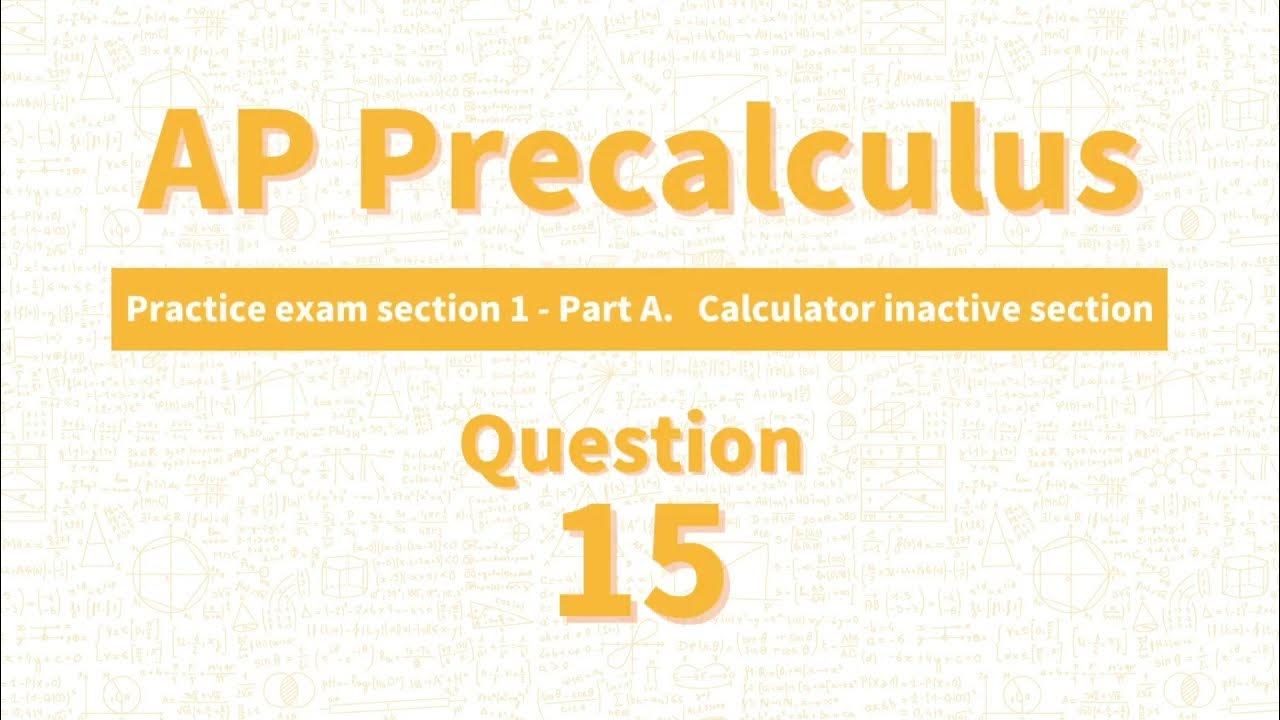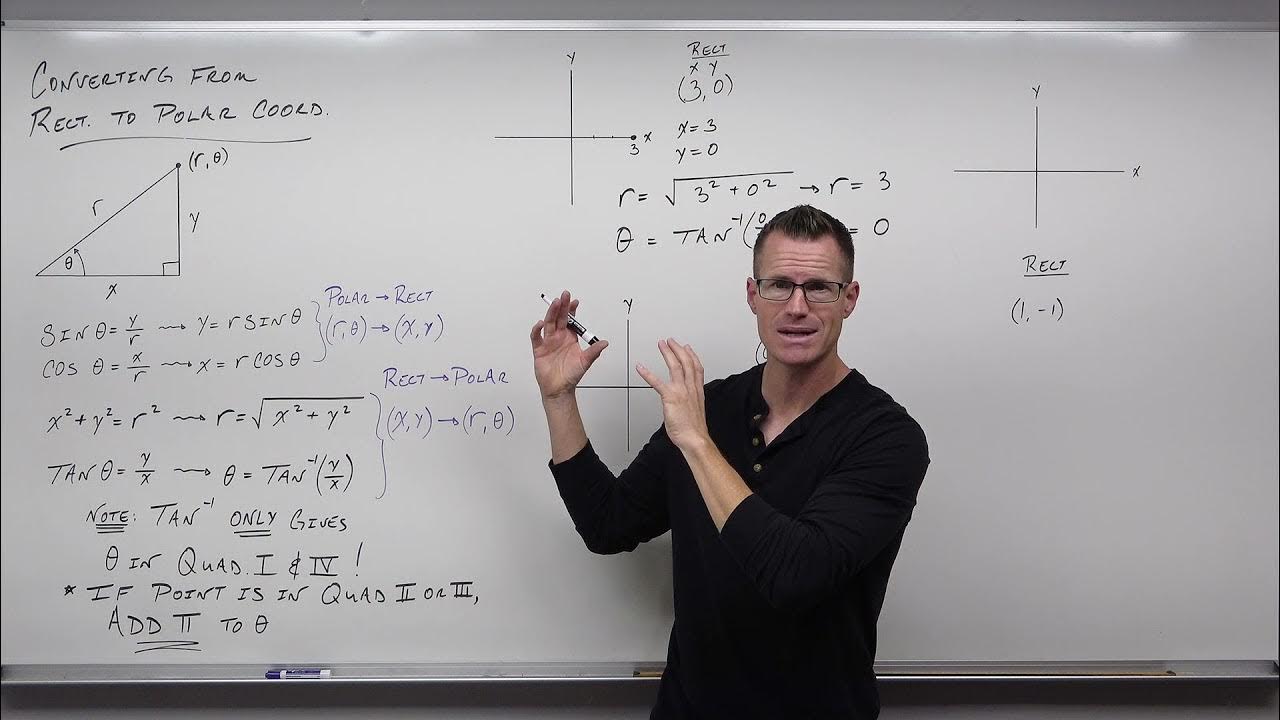AP Precalculus Practice Exam Question 26
TLDRThe script discusses a polar graph of the function R = 4cos(2θ), with a focus on the restricted domain from 0 to π/2. It explores the graph's behavior in different quadrants, identifying points A, B, C, D, and E. The analysis confirms that with the restricted domain, the graph's remaining section includes a segment from C to E in the first quadrant and from E to D in the third quadrant. Calculations for θ = 0, π/4, and π/2 support this, showing R values of 4, 0, and -4, respectively, which helps in visualizing the graph's spiraling, counterclockwise motion.
Takeaways
- 📊 The script discusses a polar function graph where \( R = f(\theta) = 4\cos(2\theta) \) within the range \( 0 \leq \theta \leq 2\pi \).
- 📍 Points A, B, C, D, and E are labeled on the graph, indicating specific positions related to the function's behavior.
- ⚖️ The domain of the function is restricted to \( 0 \leq \theta \leq \pi/2 \), changing the visible portion of the graph.
- 🔄 Polar functions are described as spiraling in a counterclockwise motion, which helps in visualizing the graph's behavior.
- 🔍 The script suggests that the graph will loop from point C to E and then back to D, following the counterclockwise spiral pattern.
- 📐 The script verifies the function's behavior by calculating \( R \) values for \( \theta = 0 \), \( \pi/4 \), and \( \pi/2 \).
- 🔢 At \( \theta = 0 \), \( f(0) = 4 \), placing the graph at point C with an \( R \) value of 4.
- 📉 At \( \theta = \pi/4 \), \( f(\pi/4) = 0 \), indicating the graph is at the pole, transitioning from C to E.
- 📈 At \( \theta = \pi/2 \), \( f(\pi/2) = -4 \), placing the graph at point D in the third quadrant.
- 🔮 The remaining piece of the graph, after domain restriction, is from point E to D in the third quadrant.
- 🎯 The correct answer to the question about the remaining piece of the graph is 'D', indicating the section from E to D.
Q & A
What is the given polar function in the script?
-The given polar function is R = f(θ) = 4cos(2θ).
What is the range of θ for the original graph?
-The original graph is defined for 0 ≤ θ ≤ 2π.
How many points are labeled on the graph, and what are their labels?
-There are five points labeled on the graph: A, B, C, D, and E.
What is the restricted domain of θ for the new graph?
-The restricted domain of θ is from 0 to π/2.
What is the relationship between the points C and E in the restricted graph?
-In the restricted graph, the portion from C to E remains in quadrant one.
What is the significance of the counterclockwise spiraling motion in polar functions?
-The counterclockwise spiraling motion indicates the direction of the graph's progression, helping to determine the path from one point to another.
What is the R value when θ is 0?
-When θ is 0, the R value is 4, as cos(2*0) = 1 and 4*1 = 4.
What is the R value when θ is π/4?
-When θ is π/4, the R value is 0, as cos(2*π/4) = cos(π/2) = 0 and 4*0 = 0.
What is the R value when θ is π/2?
-When θ is π/2, the R value is -4, as cos(2*π/2) = cos(π) = -1 and 4*(-1) = -4.
What is the remaining piece of the graph after the domain restriction?
-The remaining piece of the graph is in quadrant three, from point E to D.
What is the correct answer to the question posed in the script?
-The correct answer is D, as it describes the other remaining piece of the graph after the domain restriction.
Outlines
📈 Polar Graph Analysis: Restricting Domain to π/2
The paragraph discusses the analysis of a polar function graph, R = 4cos(2θ), within the restricted domain from 0 to π/2. It explains that the graph will show two distinct pieces due to the domain restriction. The first piece is in the first quadrant from point C to E. The second piece, which is the focus of this paragraph, is in the third quadrant from point E to D. The explanation includes a step-by-step calculation of the R values for specific theta values (0, π/4, and π/2) to verify the graph's behavior within the restricted domain. The calculations confirm that the graph transitions from point C to E and then to point D, aligning with the spiraling counterclockwise motion characteristic of polar functions.
Mindmap
Keywords
💡Polar function
💡Graph
💡Theta
💡Cosine
💡Domain
💡Quadrant
💡Points A, B, C, D, and E
💡Spiral
💡Counterclockwise motion
💡R values
Highlights
The figure shows the graph of the polar function R = 4cos(2θ) for 0 ≤ θ ≤ 2π.
There are five points labeled A, B, C, D, and E on the graph.
When the domain of f is restricted from 0 to π/2, the portion of the graph that remains contains two pieces.
One of the remaining pieces is the portion in quadrant one from point C to E.
Polar functions are built with a spiraling counterclockwise motion.
The function is likely to go from point E to D after starting at C.
Calculating R values for θ = 0, π/4, and π/2 helps verify the restricted domain section.
At θ = 0, R = 4 (point C).
At θ = π/4, R = 0 (pole in the middle, point E).
At θ = π/2, R = -4 (point D).
The next section of the polar curve is from the center point E to D in quadrant three.
The correct solution for the remaining piece is from point E to D.
The analysis uses a combination of visual inspection and mathematical calculation.
Understanding the spiraling nature of polar functions is key to solving the problem.
The restricted domain from 0 to π/2 results in a specific section of the graph.
Calculating specific R values confirms the expected behavior of the polar function.
The problem demonstrates the application of polar coordinates and trigonometric functions.
The solution process involves both theoretical understanding and practical calculation.
Transcripts
5.0 / 5 (0 votes)
Thanks for rating:





